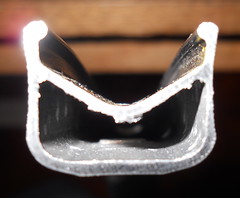Consumables
I finally got around to replacing the somewhat worn rear wheel on my trek and, as is traditional, I took a picture of the rim wear after I sawed the rim in half so I could stuff it into recycling.
It was kind of worn. The new rear wheel (a handbuilt wheel with a Shimano “Silent Clutch” 7-speed freehub, straight-gauge spokes, and an Alex DC19 rim) brakes amazingly well compared to the leisurely creep to a stop that the old rim was capable of – with the new rim, clamping down on the brake puts the rear wheel into a skid even on dry pavement, which makes me wonder why it took me so long to sit down and start wheelbuilding after I built a front wheel for the MLCM.
The trek is now spookily silent when I’m coasting, which makes up for the rear hub weighing approximately a ton.
Comments
The most worn side is the driveside; I think the drivetrain collects extra gunk (the Trek doesn’t have mudflaps, so I get a lot more stuff spattering up into the bottom bracket/crankset area) and spits it out onto that side of the rim, so it has SUPER SCOURING ACTION™ on that brake surface.
I only see this kind of wear on the rear wheel, which is not my primary braking surface. The front wheel on the trek, on the other hand, still has a rim wear notch and everything despite having almost as much (10k instead of 12k miles; I bought it a few months after the xtracycle conversion) wear and being a used wheel I bought from someone on the iBob list.
If my front wheels were getting burned up at nearly the rate of my rear wheels, I’d be out there with a non-toy torch brazing together disk forks for the front (and putting a drum brake on the back) of each of my bicycles!
That makes sense. (Though that is a lot of glop. I clearly need to revisit my expectation that winter in Toronto is a gloppy time.)
Honestly, though, wheel stresses and lawyer lips and issues of aesthetics aside, so far as I can tell, disc brakes are just better, not least because crud on the rim has no opportunity to produce infinite drag.
To be honest, the only thing I can think of that’s not good about disk brakes is that they’re just another thing that needs to be tweaked with when I’m building up a bicycle (or replacing a wheel after a flat. That’s why I mentioned putting a drum brake on the rear – there are a lot of fiddly things you need to fit the wheel around when you’re putting it back in, and a disk brake is just one more fiddly bit.) The retention lips are only needed when the fork is built wrong (the brake should be in front of the fork leg, so the forces attempt to drive the axle up into the crotch of the drop-out instead of out the open end of the thing.
Aesthetically they’re fine; they haven’t been around long enough to fall victim to the lure of bike part blingification!
I am doubtless a bit biased, having now gone three years with no flats, but I don’t find disc brakes to be a major fiddly bit when replacing wheels. The front low-rider rack, emphatically; the dynamo hub cable, much too often. But the brakes themselves – these are Avid BB7s – aren’t a problem.
They’re also way easier to adjust than caliper brakes (at least in my experience of caliper brakes) and much more forgiving of the rim going out true, which is a bit of two-edged thing. (The rim can get a long way out of true before one notices.)
Comments are closed

You’re doing nearly as much as the “didn’t work at all, downhill in the rain into crossing traffic beside a deep ditch” incident to make me glad I swore off rim brakes.
Though if I were using those rim brakes, I’d be wondering why the wear was so asymmetric; the right side (in the picture) looks almost twice as worn as the left.